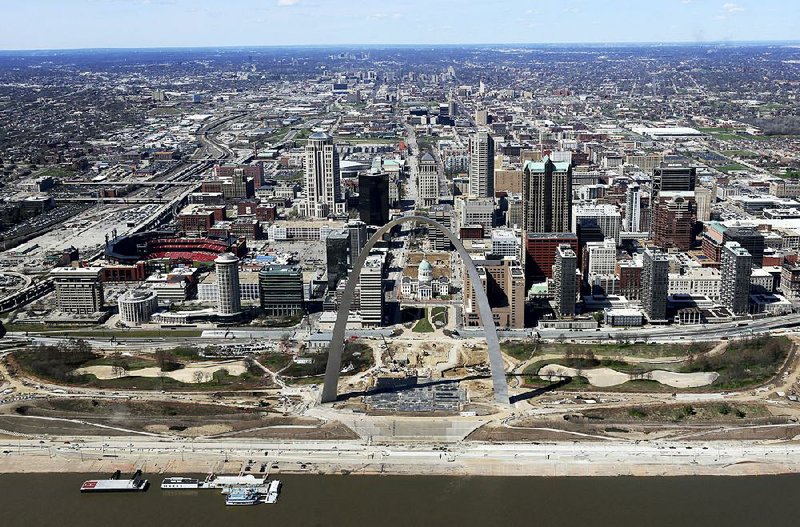ST. LOUIS -- St. Louis is experiencing a surprising surge in business startups.
Forbes recently cited St. Louis as the fastest-growing city for startups, and the analytical website fivethirtyeight.com in the fall listed St. Louis as the second-fastest-growing startup community. The region is now home to more than 700 bioscience companies, many started in the past few years and linked to the city's universities and medical institutions.
St. Louis leaders hope the city at last has found a way to fill the gap left by the loss of Fortune 500 companies such as Trans World Airlines and McDonnell Douglas after corporate mergers, as well as the closing of manufacturing plants.
Expanded science and health employment has benefited other sagging Rust Belt cities, notably Pittsburgh, where sprawling medical complexes and research on robotics and artificial intelligence have helped replace defunct steel mills.
"I actually think the heyday of St. Louis was 1904," said Dedric Carter, who oversees entrepreneurship efforts at Washington University in St. Louis. "There were certainly down cycles in years after that. But I look at the future as harkening back to that heyday that was 1904, when there was great building, there was great innovation."
St. Louis was the nation's fourth-largest city in 1904, the year it hosted both the Olympics and the World's Fair. Since then, a half-million in population has been lost to the suburbs, with the remaining 320,000 residents putting it at 60th in population.
Still, the city's serious problems make it unclear how far the revival will go. Despite highly publicized efforts to create more economic opportunity in the black community, 36 percent of black residents live below the poverty line, compared with 15 percent of whites. And in a city nearly evenly split between whites and blacks, the vast majority of violent crime victims -- and assailants -- are black.
"There is so much growth and so many opportunities looking to take flight in St. Louis," said John Gaskin III, an NAACP national board member who has been active in local reconciliation efforts since the Michael Brown shooting in neighboring Ferguson in 2014. "But if we don't deal with some of the basic problems, I feel like we'll miss our mark," Gaskin said.
Geographically and socially, St. Louis has always been a mix of the industrial north and the Old South. Its population peaked at more than 850,000 in the mid-20th century. In addition to its Fortune 500 companies and Mississippi River commerce, St. Louis was second to only Detroit in automobile production.
But the suburbanization that followed World War II was especially extensive here, along with white flight. The city's population today is down 63 percent from the 1950 Census.
Assets that remained in the city included universities with specialties in medical research, along with large science-based companies like Monsanto and the life sciences firm Sigma-Aldrich. In recent years, civic leaders have tried to make science enterprises a foundation for the future.
The efforts included BioSTL, an organization established to provide seed money for biotech startups. A nonprofit called Arch Grants provides $50,000 equity-free grants and free support services for scientists and entrepreneurs.
Washington University's Office of Technology Management helps students and faculty obtain patents ranging from gene therapies to magnetics. St. Louis University has provided more than $3.3 million in capital to promising firms, said Jerome Katz, a professor of entrepreneurship.
Overall, bioscience startups now employ more than 15,000 people. Venture capital investment in St. Louis more than doubled from 2013 to 2015, according to the St. Louis Metropolitan Medical Society.
The hotspot in St. Louis is a 5-mile corridor between the two universities. At the center of it is the Cortex district, a 200-acre "innovation hub" that houses 250 new companies.
"The atmosphere here, to me, is just incredible," said Joe Monahan, whose drug research and development company, now called Confluence Discovery Technologies, opened in 2010 and now employs around three dozen scientists.
Major downtown projects are in the works, including a $380 million renovation of the area around the Arch and a $220 million expansion of Ballpark Village near Busch Stadium.
But the progress so far has focused on the young and well-educated. The sense of hopelessness in poor minority-group neighborhoods is reflected by the fact that of 127 suspects in the city's homicides in 2016, 119 were black.
"If we're going to be a 21st-century city, a thriving city with high-tech jobs and biotech jobs, half of the city's population has to be included in that formula," said Malik Ahmed, chief executive officer of Better Family Life, a nonprofit working with low-income residents. "Anybody that denies that is not living in reality."
A Section on 01/17/2017

